双语论文2
关于双语教育的英语作文
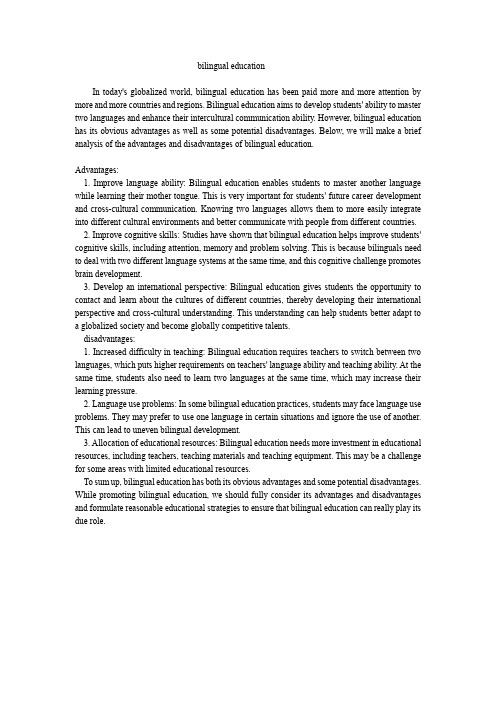
bilingual educationIn today's globalized world, bilingual education has been paid more and more attention by more and more countries and regions. Bilingual education aims to develop students' ability to master two languages and enhance their intercultural communication ability. However, bilingual education has its obvious advantages as well as some potential disadvantages. Below, we will make a brief analysis of the advantages and disadvantages of bilingual education.Advantages:1. Improve language ability: Bilingual education enables students to master another language while learning their mother tongue. This is very important for students' future career development and cross-cultural communication. Knowing two languages allows them to more easily integrate into different cultural environments and better communicate with people from different countries.2. Improve cognitive skills: Studies have shown that bilingual education helps improve students' cognitive skills, including attention, memory and problem solving. This is because bilinguals need to deal with two different language systems at the same time, and this cognitive challenge promotes brain development.3. Develop an international perspective: Bilingual education gives students the opportunity to contact and learn about the cultures of different countries, thereby developing their international perspective and cross-cultural understanding. This understanding can help students better adapt to a globalized society and become globally competitive talents.disadvantages:1. Increased difficulty in teaching: Bilingual education requires teachers to switch between two languages, which puts higher requirements on teachers' language ability and teaching ability. At the same time, students also need to learn two languages at the same time, which may increase their learning pressure.2. Language use problems: In some bilingual education practices, students may face language use problems. They may prefer to use one language in certain situations and ignore the use of another. This can lead to uneven bilingual development.3. Allocation of educational resources: Bilingual education needs more investment in educational resources, including teachers, teaching materials and teaching equipment. This may be a challenge for some areas with limited educational resources.To sum up, bilingual education has both its obvious advantages and some potential disadvantages. While promoting bilingual education, we should fully consider its advantages and disadvantages and formulate reasonable educational strategies to ensure that bilingual education can really play its due role.。
论文写作2(Academic Paper Writing)
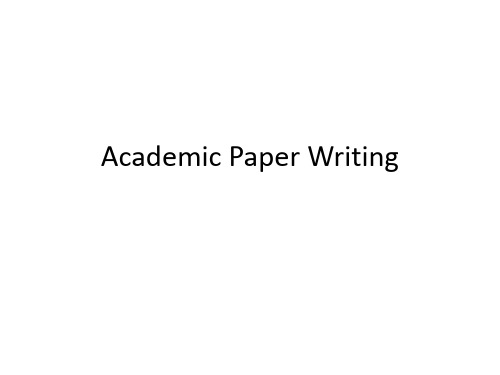
relation of equivalence.
ST≈TT or
TT≈ST
This is an approach that has close links with
contrastive linguistics and puts language system
rather than texts on either side of the relation:
We define research broadly as a systematic investigation towards increasing the sum of knowledge. Innovation is vital if a discipline is to grow and prosper.
These models are attempts to construct images of the object of study, images that hopefully make it easier to visualize, understand and analyse. In your own research project, you might take a ready model and simply use its framework and concepts unchanged or you might adapt a given model to your own purposes. Translation Studies has traditionally used three basic types of models.
• Comparative Models
The earliest theoretical model of translation was
英国文化研究相关论文范文(2)
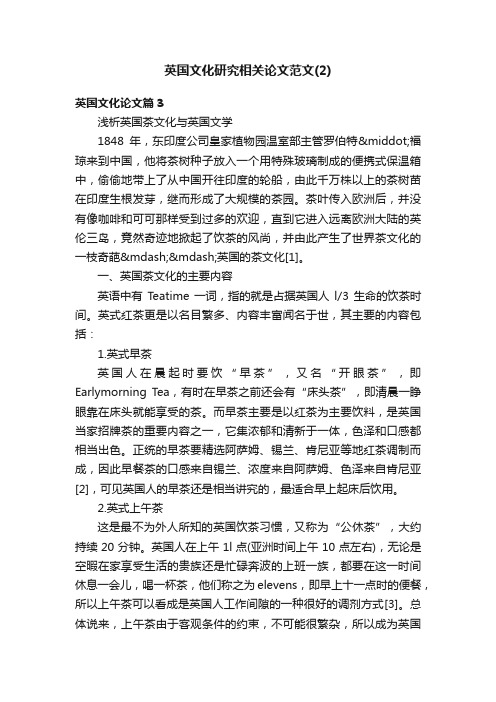
英国文化研究相关论文范文(2)英国文化论文篇3浅析英国茶文化与英国文学1848年,东印度公司皇家植物园温室部主管罗伯特·福琼来到中国,他将茶树种子放入一个用特殊玻璃制成的便携式保温箱中,偷偷地带上了从中国开往印度的轮船,由此千万株以上的茶树苗在印度生根发芽,继而形成了大规模的茶园。
茶叶传入欧洲后,并没有像咖啡和可可那样受到过多的欢迎,直到它进入远离欧洲大陆的英伦三岛,竟然奇迹地掀起了饮茶的风尚,并由此产生了世界茶文化的一枝奇葩——英国的茶文化[1]。
一、英国茶文化的主要内容英语中有Teatime一词,指的就是占据英国人l/3生命的饮茶时间。
英式红茶更是以名目繁多、内容丰富闻名于世,其主要的内容包括:1.英式早茶英国人在晨起时要饮“早茶”,又名“开眼茶”,即Earlymorning Tea,有时在早茶之前还会有“床头茶”,即清晨一睁眼靠在床头就能享受的茶。
而早茶主要是以红茶为主要饮料,是英国当家招牌茶的重要内容之一,它集浓郁和清新于一体,色泽和口感都相当出色。
正统的早茶要精选阿萨姆、锡兰、肯尼亚等地红茶调制而成,因此早餐茶的口感来自锡兰、浓度来自阿萨姆、色泽来自肯尼亚[2],可见英国人的早茶还是相当讲究的,最适合早上起床后饮用。
2.英式上午茶这是最不为外人所知的英国饮茶习惯,又称为“公休茶”,大约持续20分钟。
英国人在上午1l点(亚洲时间上午10点左右),无论是空暇在家享受生活的贵族还是忙碌奔波的上班一族,都要在这一时间休息一会儿,喝一杯茶,他们称之为elevens,即早上十一点时的便餐,所以上午茶可以看成是英国人工作间隙的一种很好的调剂方式[3]。
总体说来,上午茶由于客观条件的约束,不可能很繁杂,所以成为英国茶中最简单的部分。
3.英式下午茶英文名称Afternoon Tea,这其实才是真正意义英国茶文化载体,英国茶正是凭借其内涵丰富、形式优雅的“英式下午茶”——红茶文化享誉世界,“英式下午茶”更是成为英国人典雅生活的象征。
毕业论文的外文译文
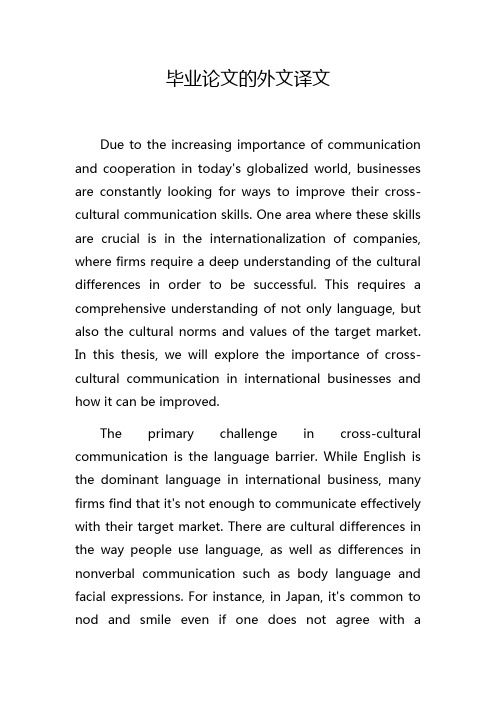
毕业论文的外文译文Due to the increasing importance of communication and cooperation in today's globalized world, businesses are constantly looking for ways to improve their cross-cultural communication skills. One area where these skills are crucial is in the internationalization of companies, where firms require a deep understanding of the cultural differences in order to be successful. This requires a comprehensive understanding of not only language, but also the cultural norms and values of the target market. In this thesis, we will explore the importance of cross-cultural communication in international businesses and how it can be improved.The primary challenge in cross-cultural communication is the language barrier. While English is the dominant language in international business, many firms find that it's not enough to communicate effectively with their target market. There are cultural differences in the way people use language, as well as differences in nonverbal communication such as body language and facial expressions. For instance, in Japan, it's common to nod and smile even if one does not agree with astatement, whereas in the United States, a lack of disagreement often means agreement. These differences can lead to misunderstandings in business conversations, which can ultimately harm business relationships.In order to overcome these language barriers, companies need to invest in language training for their employees. This training should focus not only on the language itself, but also on the cultural norms and values associated with the language. For example, a Japanese training program might teach students about the concepts of harmony and respect in Japanese culture, and how these values influence the way people communicate with each other. By understanding these cultural norms, employees will be able to communicate more effectively with their Japanese counterparts.Another challenge in cross-cultural communication is understanding the cultural context of business interactions. In some cultures, business is conducted in a more formal manner, with a strong emphasis on hierarchy and protocol. In other cultures, business is more informal and relaxed. Companies need to understand these differences in order to work effectively in international markets.To overcome these context challenges, companies should incorporate cultural training into their employee training programs. Cultural training should focus on the history, customs, and traditions of the target market. It should also address the specific business practices and protocol required for success in that market.In conclusion, cross-cultural communication is a key determinant of success in international businesses. In order to succeed in foreign markets, companies must have a deep understanding of the language, cultural norms, and values of their target market. This requires a comprehensive training program that not only focuses on language skills, but also on the cultural context of business interactions. With the right training and support, companies can improve their cross-cultural communication skills and achieve success in global markets.。
英语学术论文写作教程-Unit 2

Unit 2 Introduction
Overview
A good beginning is half done, so is a research paper. One is to arouse the readers’ interest, and the other is to offer adequate information to prepare readers for understanding the paper and evaluating the worth of the study. In terms of structure, a well-organized Introduction presents a funnel shape, or in other words, it begins with stating general research scope and then narrows down to the research focus. In order to write an effective Introduction, Swales & Feak (2012) proposes a widely used discourse pattern, known as the Create-a-Research-Space (or CARS) model.
Information Convention
❶With the rapid development of chemical industry, heavy metals in environment increase rapidly and go beyond the normal range, which has seriously polluted the soil. ❷ Such soil contamination leads to deterioration of environmental quality and does harm to human’s health. ❸ So, it is important to control soil pollution caused by heavy metals.
英文科技论文写作 第2课. The Title of paper
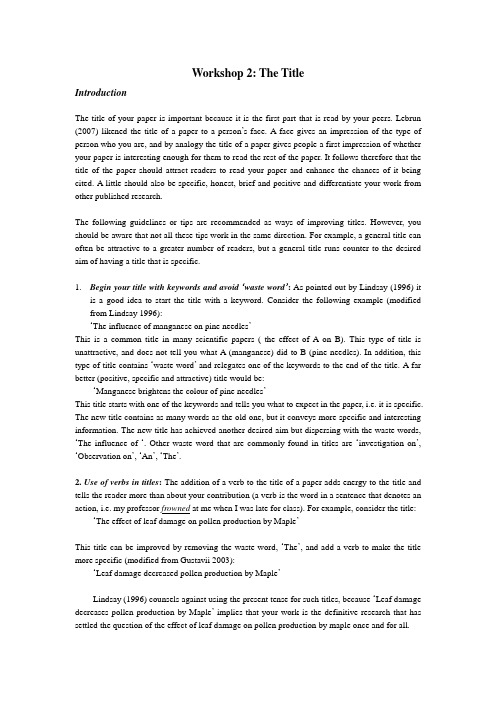
Workshop 2: The TitleIntroductionThe title of your paper is important because it is the first part that is read by your peers. Lebrun (2007) likened the title of a paper to a person‟s face. A face gives an impression of the type of person who you are, and by analogy the title of a paper gives people a first impression of whether your paper is interesting enough for them to read the rest of the paper. It follows therefore that the title of the paper should attract readers to read your paper and enhance the chances of it being cited. A little should also be specific, honest, brief and positive and differentiate your work from other published research.The following guidelines or tips are recommended as ways of improving titles. However, you should be aware that not all these tips work in the same direction. For example, a general title can often be attractive to a greater number of readers, but a general title runs counter to the desired aim of having a title that is specific.1.Begin your title with keywords and avoid ‘waste word’: As pointed out by Lindsay (1996) itis a good idea to start the title with a keyword. Consider the following example (modified from Lindsay 1996):…The influence of manganese on pine needles‟This is a common title in many scientific papers ( the effect of A on B). This type of title is unattractive, and does not tell you what A (manganese) did to B (pine needles). In addition, this type of title contains …waste word‟ and relegates one of the keywords to the end of the title. A far better (positive, specific and attractive) title would be:…Manganese brightens the colour of pine needles‟This title starts with one of the keywords and tells you what to expect in the paper, i.e. it is specific. The new title contains as many words as the old one, but it conveys more specific and interesting information. The new title has achieved another desired aim but dispersing with the waste words, …The influence of …. Other waste word that are commonly found in titles are …investigation on‟, …Observation on‟, …An‟, …The‟.2. Use of verbs in titles: The addition of a verb to the title of a paper adds energy to the title and tells the reader more than about your contribution (a verb is the word in a sentence that denotes an action, i.e. my professor frowned at me when I was late for class). For example, consider the title: …The effect of leaf damage on pollen production by Maple‟This title can be improved by removing the waste word, …The‟, and add a verb to make the title more specific (modified from Gustavii 2003):…Leaf damage decreased pollen production by Maple‟Lindsay (1996) counsels against using the present tense for such titles, because …Leaf damage decreases pollen production by Maple‟ implies that your work is the definitive research that has settled the question of the effect of leaf damage on pollen production by maple once and for all.The following title contains a verb and also has a …keyword‟ placed first (modified from Lebrun 2007):…High resolution numerical models: understanding satellite data‟This type of title is known as a hanging title and some very good journals such as …Science‟advocate their use. Other disagree, for example, Day (1998) states that hanging titles “appear pedantic, often place the emphasis on a general term rather than a more specific term, necessitate punctuation, scramble indexes and in general provide poor titles”.3. Declarative rather than neutral titles: whenever possible use a declarative rather than a neutral title. The following title is neutral (from Gustavii 2003):…The influence of aspirin on prostaglandin synthesis‟A far better title is:…Inhibition of prostaglandin synthesis as a mechanism of action of aspirin-like drugs‟This title incorporate keywords at the beginning and introduces verbs to make the title more specific and informative. Most journals will accept declarative titles, although a few still ask for non-declarative titles.4. Adjectives and numbers to make a title more memorable: An adjective is a word whose main role in a sentence is to modify a noun (name of a person, place or thing). For example, my sister is a fast runner. The incorporation of an adjective or adverb (modifiers of verbs, adjectives and clauses) in a title is often used to describe the key aspect of a contribution, i.e. fast, highly efficient, or robust algorithms. A void terms such as new or novel as your work may outlive you and become old and outdated. It is also preferable, as pointed out by Lebrun (2007) to make your adjective less subjective by prefacing it with a number i.e. use ‟20 MHz computer‟rather than …extremely (adverb) fast computer‟because fast computers may become slow over time making them …extremely fast computer‟ very misleading.5. Unexpected or unusual words: Another technique to attract readers and make your title more memorable is to include an unexpected or unusual word. Consider the following example (from Lebrun 2007):“Hydrophobic property of sol-gel hard coating”This is a rather general title, but as pointed out by Lebrun (2007) it has the virtues of being short and specific. The following title, however, is better:“Increasing hydro-phobicity of sol-gel hard coating by chemical and micromorphological modifications” (Lebrun 2007)This title is more specific (honest) and representative of the work. It adds keywords making it easier to find by search engines and it clearly tells the reader how increases in hydro-phobicity were achived. The title has lost conciseness because it is longer, but it has gained in appeal because it starts with the verb …increasing‟. The following, alternative title is more catchy and might attract readers from outside of the field of manufacturing and coatings, for examplebiologists (from Lebrun 2007):“Increasing hydro-phobicity of sol-gel hard coatings by mimicking lotus leaf morphology”This title has lost two important keywords (chemical and morphological modifications), however, this deficiency might be rectified by placing the keywords in the list of keywords that follows the journal abstract (from Lebrun 2007).Care should be exercised when including catchy terms in titles. Sometimes these terms may not make sense to people living in other parts of world, as is the case for the following titles (taken from Lebrun 2007).“The inflammatory microphage a story of Jekyll and Hyde”“The abc‟s (& xyz‟s) if peptide sequencing”6. Making titles catchy by posing a question: Hanging titles posed as questions such as the following can make catchy and interesting titles:“Software acceleration using programmable logic: is it worth the effect” (from Lebrun 2007) “Wax and oil emulsion additives : How effective are they at improving the performance of preservative-treated wood”However, titles like these are best reserved for those who are quite well established in their fields, otherwise they could be considered as being rather arrogant. Day (1998) states that titles posed as questions should not used at all.7. Pitfalls and things to avoid: Titles of papers should not contain abbreviations, acronyms, trade names and clichés (jargon). There are some exceptions to this general rule. For example, some acronyms and abbreviations are more common than the words they stand for such as pH and DNA. In such cases it is acceptable to use the abbreviation. If in doubt spell out the abbreviation in full and include the abbreviation in brackets. Similarly it is acceptable to include an acronym in a title if you are introducing it for the first time, as is the case for the following title taken from Lebrun (2007):“VISOR: learning v isual s chemas in neutral networks for o bject r ecognition and scene analysis”Outdated words which have lost their meaning should also be avoided i.e. animalcules for bacteria and protozoa (Day 1998).Titles are not usually sentences rather they are labels. Nevertheless, you should be careful of syntax. Most problems in this area stem from the order of words in the title as is the case for the following title (Day 1998):“Multiple infections among newborns resulting from implantation with staphylococcus aureus”(This is title indicates that newborns result from implantation with the bacteria staphylococcus aureus) !Other consideratrionsRunning titles: Most journals include a running title for your paper, which is printed at the top (running head) or bottom (running foot) of every page, or alternate pages. Some journals create this running title from the full title that you supply, but others will ask you to provide a running title. The running title is shorter than then full title, and when you prepare it, you should focus on the keywords and the subject of the paper.“Hydrophobicity of sol-gel coatings” (from the earlier title in Lebrun 2007)Thesis title: Thesis titles can be longer than titles for a paper and some non-experts might be interested in your thesis as well as experts (peers). Therefore, a useful approach way of pleasing both audiences is to create a hanging title with the first being intelligible to non-experts and a sub-heading containing more specific details, i.e.:“Modification of wood with cold plasma with emphasis on the morphological and chemical changes to wood cell walls”Series titles: The priority given in academia to publishing large numbers of papers has led some scientists to publish their research findings in a series. In some quarters this practice is known as …slicing the salami thin‟. Titles for such papers are generally hanging titles with the number of paper taking the place of the question in the hanging titles mentioned earlier:“Thermal modification of red alder:1. The effect of temperature and duration of heating”There are a number of objections to a title like this. Firstly, the initial part of the title is too general and becomes redundant in subsequent papers published in the series. In addition the meaning of the individual papers in the series only becomes clear when the series is read as a whole. Papers should be cohesive documents that are intelligible without reference to other papers. Hence, for these reasons papers in series are disliked by editors and also referees who have to referee two or three papers at a time (rather than one good paper)! Problem can also arise for authors and their peers if some of papers in the series are accepted and other are rejected.ReferencesDay, R.A. (1998). How to write and publish a scientific paper (5th edition), Oryx Press, West port C T.Gustavii, B. (2003). How to write and illustrate a scientific paper. Cambridge University Press, Cambridge.Lebrun, J-L. (2007). Scientific writing. A readers and writer‟s guide. World Scientific Publishing Co, Singapore.Lindsay, D. (1996). A guide to scientific writing (2nd edition), Longman, Melbourne.。
英文作文中的议论文范文

英文作文中的议论文范文英文:Today, I want to talk about the importance of learning a second language. As someone who speaks both English and Chinese, I can attest to the many benefits of being bilingual.Firstly, being bilingual can open up many job opportunities. In today's globalized world, companies are looking for employees who can communicate with clients and colleagues from different countries. Being able to speak a second language can give you a competitive edge in the job market.Secondly, learning a second language can improve your cognitive abilities. Studies have shown that bilingual individuals have better problem-solving skills and are able to multitask more effectively. Additionally, learning a second language can delay the onset of Alzheimer's diseaseand other forms of dementia.Lastly, being bilingual can enhance your travel experiences. When you are able to communicate with localsin their own language, you can gain a deeper understanding of their culture and way of life. You can also navigate your way around the country more easily and avoid getting lost or scammed.In conclusion, learning a second language is a valuable skill that can benefit you in many ways. Whether it's for career advancement, cognitive development, or travel purposes, there are many reasons why you should consider learning a second language.中文:今天,我想谈谈学习第二语言的重要性。
(原创英语小论文)Paper-Choice of Correct Words in Translation
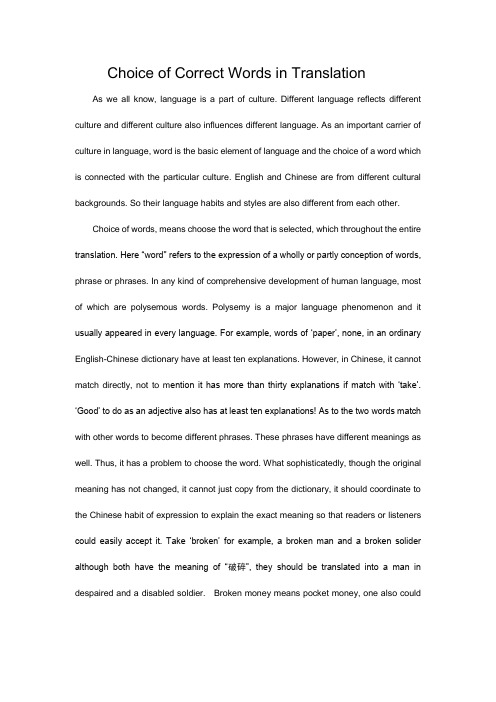
Choice of Correct Words in Translation As we all know, language is a part of culture. Different language reflects different culture and different culture also influences different language. As an important carrier of culture in language, word is the basic element of language and the choice of a word which is connected with the particular culture. English and Chinese are from different cultural backgrounds. So their language habits and styles are also different from each other.Choice of words, means choose the word that is selected, which throughout the entire translation. Here “word" refers to the expression of a wholly or partly conception of words, phrase or phrases. In any kind of comprehensive development of human language, most of which are polysemous words. Polysemy is a major language phenomenon and it usually appeared in every language. For example, words of …paper‟, none, in an ordinary English-Chinese dictionary have at least ten explanations. However, in Chinese, it cannot match directly, not to m ention it has more than thirty explanations if match with …take‟. …Good‟ to do as an adjective also has at least ten explanations! As to the two words match with other words to become different phrases. These phrases have different meanings as well. Thus, it has a problem to choose the word. What sophisticatedly, though the original meaning has not changed, it cannot just copy from the dictionary, it should coordinate to the Chinese habit of expression to explain the exact meaning so that readers or listeners could easily accept it. Take …broken‟ for example, a broken man and a broken solider although both have the meaning of “破碎”, they should be translated into a man in despaired and a disabled soldier. Broken money means pocket money, one also couldnot translate it directly. All of what I just said concerned with how to choose the correct words in translation.Here are four aspects about choosing correct words in translation:Ⅰ. Polysemy and Synonyms in TranslationEnglish and Chinese are both abundantly and developed language. Both of them have polysemy and synonyms. For example,“爬”means walking insects, but it also refers to the people walking together with the action. It can also be extended to "climb", such as "climbing", "climb the ladder" and so on. However, in some languages master‟s pen, …climb‟ is cleverly used to describe many other things, such as: …顺着山脚爬出去的公路‟,…春天爬上了柳梢‟. Similarly, synonyms is also very common phenomenon in English, for example, the original meaning of …hand‟ are just meaning a bout forelimb thing, but now it can be extended for the following meanings: : ① She is a good hand at pig ( she is an expert in raising pigs) .) ② M r·Hunter suddenly failed and all hands in the m ill w ere sacked (Mr. Hunter bankrupt suddenly, all the factory workers have been laid off.). Furthermore, …run‟ means an action originally, but runs for president, run a factory, run the blockade, run short have different explanation about …run‟. Chinese, “跑买卖”still cannot just translate by …run‟ . Considering t hat, we usually use different translated words to express the same word in a text which may means different, for example, King Lear told the servant of the castle to tell Regan and her husband that he had arrived and wished to see them at once. With the sa me word …tell‟, the subject is the king, the object is the servant, so the first …tell‟ should be translated into …吩咐‟;if the subject is the servant and the object is the king, it should be translated into …禀告‟. We can draw a conclusion thatonly by comparing and selecting words carefully in translation can we have words appropriately and correctly.⑴Analyze the intens ity of a word. Destroy in Chinese have three meanings, …损坏‟,…破坏‟ …毁坏‟. In Chinese, these three words mean different severity of one thing. "破坏" have a meaning of "intentionally "; and "毁坏" have a meaning of " completely " .Thus, in …The enemies destroyed a lot of bridges when they escaped‟, destroy translated into "破坏". Taking a another example: Unfortunately, he was not in when I managed to find his home. Here unfortunately only translated into"不巧" rather than "不幸". Otherwise, it seemed too serious.⑵Analy ze the meaning of words collection. In Chinese, …胖‟refers to someone is fat, but…肥‟refers to animal. Both of the situation use …fat‟ to describe in English. Thus, many foreigners often confuse them. …肥孩子‟is an example. Therefore, know the habitual word combination when choose a word in translation is important.⑶Analyze the meaning and emotional color of a word in translation. In Chinese and English, there are collections of words to express …yes or no‟, …like or dislike‟. Therefore, in the process of tran slation, if we confuse the emotional color of a word, the article‟s appealing will decline; even misunderstand the article‟s main idea. Take this sentence for example, we had been conferring without allies on the crucial question of whether and when the is land should be invaded. In this sentence, …invade‟ means at tack and spread in to, so as to take control of a country, city etc. In Chinese, …入侵‟and …进攻‟can express the meaning of invade, but the subject in this sentence is we, we should use the positive word-入侵rather than negative word-进攻. …He had deep disrupt for the old school of theGrammar ruling class. They were rigid, embittered by defea t rigid ‟,the meaning of rigid is not easy to change, Therefore, the translation of this word should choose …顽固不化‟rather than …顽强不屈‟,it express the author‟s prejudice about German ruling class.Ⅱ.Different Meanings of a Word in TranslationMost of words h ave its‟ literal meaning and implicit meaning. Because of cultural backgrounds in English and Chinese, its‟ affiliated words have different connotations. If we do not understand the implicit meaning, only translate a word by its literal meaning, we would make a wrong translation and make listeners or readers puzzled. For example, in American English, Politian often contain a negative meaning, it refers to someone who wants to seek their own interest by engaging in political maneuvering. When it translated i nto Chinese, we should utilize …政客‟rather than …政治家‟. …野心勃勃‟in China has a negative meaning. People often confuse ambiguous with greedy and ruthless. However, in English, it contains a compliment meaning, it usually describes someone is hardworking. Thus, …poor and ambiguous‟ cannot translate into …穷而野心勃勃‟but …壮志满怀, 勤奋努力‟. …quite frankly, I‟m a materialist. I've got it in a good. Paying job and I want to keep it. I have bought my own flat, and my wife and I want to enjoy the comforts of life'. If we translate …materialist‟ into …唯物主义者' we could see from the context that it is clearly wrong. The concept meaning of …唯物主义‟ in Marxist philosophy in China uses different from the context. Therefore, we should translate it into …实用主义者‟.Ⅲ.The Rhetoric about Choose Words in TranslationEach nationality has its own history, culture, politic. Therefore, because of unique historical development, living standard, customs, the way of thinking, aestheticconceptions, Chinese and English are different. Rhetoric, as a part of speech art, of course, influenced by culture. In translation, if we just depend on our own culture‟s habit to modify English, we cannot avoid cultural conflicts. Therefore, translated by our own rhetorical format, just copy the image of the original metaphor, it cannot only lose the original style but also obscure and distort the meaning of the original sentence. For example, as stupid as a goose, in Chinese, pig is a symbol of stupid, so when we translate it, we should say …笨得像猪‟; work like a horse, translated into …像老黄牛一样干活‟; red as rose, translated into …艳如桃李‟; a heart as hard as flint, is a simile in English, but our translation …铁石心肠‟is a metaphor; …she was dressed in a maid‟s cap , apron, and a bright smile‟, this sentence should not translate into…她戴着女仆帽、围腰和明亮的微笑。
The Cultural Differences between English and Chinese Animal英语专业毕业论文
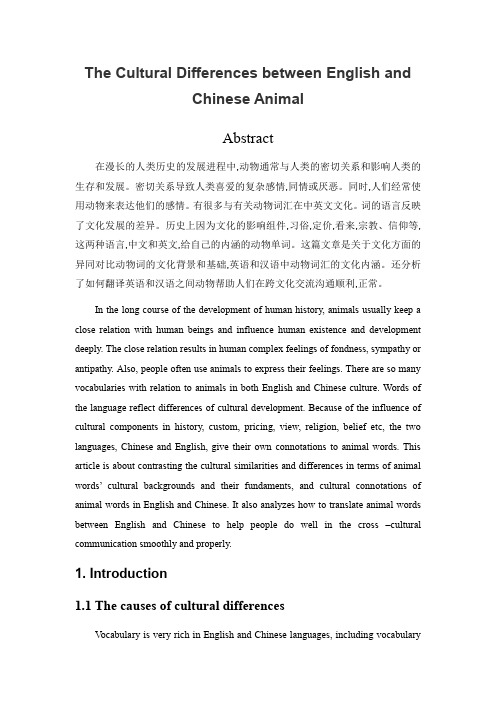
The Cultural Differences between English andChinese AnimalAbstract在漫长的人类历史的发展进程中,动物通常与人类的密切关系和影响人类的生存和发展。
密切关系导致人类喜爱的复杂感情,同情或厌恶。
同时,人们经常使用动物来表达他们的感情。
有很多与有关动物词汇在中英文文化。
词的语言反映了文化发展的差异。
历史上因为文化的影响组件,习俗,定价,看来,宗教、信仰等,这两种语言,中文和英文,给自己的内涵的动物单词。
这篇文章是关于文化方面的异同对比动物词的文化背景和基础,英语和汉语中动物词汇的文化内涵。
还分析了如何翻译英语和汉语之间动物帮助人们在跨文化交流沟通顺利,正常。
In the long course of the development of human history, animals usually keep a close relation with human beings and influence human existence and development deeply. The close relation results in human complex feelings of fondness, sympathy or antipathy. Also, people often use animals to express their feelings. There are so many vocabularies with relation to animals in both English and Chinese culture. Words of the language reflect differences of cultural development. Because of the influence of cultural components in history, custom, pricing, view, religion, belief etc, the two languages, Chinese and English, give their own connotations to animal words. This article is about contrasting the cultural similarities and differences in terms of animal words’ cultural backgrounds and their fundaments, and cultural connotations of animal words in English and Chinese. It also analyzes how to translate animal words between English and Chinese to help people do well in the cross –cultural communication smoothly and properly.1. Introduction1.1 The causes of cultural differencesV ocabulary is very rich in English and Chinese languages, including vocabularyrelated to the animals very much.Animal words refer to words and said animals including these words phrases and other idioms.These words not only can vividly show a certain quality, personality, and can describe some events and succinctly convey certain emotions.In daily life, animal words with rich expressive force, are often used to express their feelings, enrich their own language, language has been integrated into the people of all nationalities, and for people to accept and widely used.Because of the difference of all ethnic groups, all sorts of animals are endowed with moral with strong national culture characteristic and the profound historical origin, cultural connotation of animal words in English and Chinese differ greatly, embodies the cultural background of the groups to which he belongs.Due to the two peoples lives for a long time in different cultural background, naturally to the same animal word different association, endowed with abundant cultural connotation of animal words in a more.2. Comparative Study on Animal Words in English and Culture2.1 Animal Word—DogChinese and English people like to have a dog, but as a result of national customs and habits of dogs have different views, the image of the "dog" in both English and Chinese, there are differences.The Chinese have a dog has a long history.The ruling class in ancient China musicians often love to play with a dog, national policy, has four of the wars and said "outside the royal palace treasures, dog Ma Shi stables and beauty under Chen."Here are written "timbres total" ruler is dissolute erosion life portraiture.Hoarders and affluent family dog to see door, and often put a dog bite, the resulting "or", "seeing dogs were low," such as idioms.In addition, in Chinese views, the dog is always dirty lowly animals, people generally have an aversion to the dog on the psychological, the image of the dog is often used to describe actions mean bad or ugly bad thing.In Chinese, the dog has the meaning of "cheerleading, accomplice",give a person the lenovo is disgusting things, there are "dog, the dog slave", "or", "dog take a mouse", "a coward", "the dog's mouth emits no ivory", "asshole" and so on.Although a dog some of the advantages of good with the Chinese, such as loyalty, brave, intelligent, but I can't put it in China is very important position;In the west, the dog is "men 's best friend".In English, there are many good words about the dog of choose and employ persons.Such as: You 'r e a lucky dog (You are a lucky man.;Man; and fun of a gay dog (merry);A top dog (senior);The bush during the campaign says, "I will put into a campaign to like a dog fight."In the English language, of course, also has a derogatory sense of the term "dog" a dog 's life (dog's life);A yellow dog (contemptible man), dog eats dog (the competing heavily, refers to a bad situation).Again as the magpies (pay-per-tweet), Chinese have a good news, they say "called magpie branches, an occasion came to".But in English means "speak ill of others behind their backs," as the poet John Clare: pay-per-tweet that chatted, no komen so black (Magpie noise is the worst, one million).2.2 Animal Word—BatThe batsare mammals, insects such as mosquitoes and moth.In western folklore, the bat is an evil animal, always linked with sin and darkness.Mention the bat, think English people to deliberate (vampire bats).Legend deliberate from the grave at night to eat sleep is blood, let a person fear and disgust.Some English idioms in the table also shows that for the bat bad associations, such as the as blind as a bat (blind as a bat);Crazy as a bat (crazy as a bat), etc.Bats in the have nationality, however, due to its pronunciation and "f" word is the same, and therefore is considered a good luck, happiness and longevity and health of our country's traditional picture the bats and deer design together, constitute a deer "bat" (pronounced "blessing"), on behalf of riches, bless the people the meaning of "blessed with green".And because "red bat" and "most" unisonant, so red bat is a symbol of good luck.There are a lot of the same animal words in English and Chinese two languages with different cultural connotation, reflects the huge differences between English and Chinese two kinds of culture, reflect the national culture personality.2.3 Animal Word—DragonDragons are the wings and a mouse, a huge mouth to jet fire lizard.In English, the dragon represents the "atrocious - cruel" and "evil, evil," dragon on behalf of evil and the devil, if the woman likened to the dragon, means that the woman is fierce and unpleasant.(1) She is a dragon, so you had betterkeep away from its ehrs. (2) She is a bit of a dragon around the lace, however, in Chinese, the meaning of dragon and English LTD is just the opposite.In Chinese, giving people the blessing, auspicious dragon is a dragon is a symbol of auspiciousness and rights.In feudal society and even today, the dragon has a high status in Chinese: the feudal society, the dragon is the symbol of the king and the supreme ruler.Today, I am a descendant of the dragon, the descendants of the dragon, dragon become our Chinese totem. for example: (1) long To hope one 's son will have a brightfuture. (2) Long Zilong sun - the sons and grandsons of dragon. Itis usually informs the to call oneself by Chinese people.Dragon (dragon) is a mythical animals of the Chinese and western culture.Auspicious distinguished "dragon" in Chinese and English in the vicious evil dragon in stark contrast.In Chinese culture, the dragon is a symbol of auspiciousness, authority, dignity and prosperity.The Chinese nation is the "descendants of the dragon".In the feudal society, the dragon is the symbol of the emperor, emperors are called himself "the real dragons".Today, the dragon in the Chinese people's heart is still the supreme, we put our own country known as the "Oriental dragon", the dragon can be seen as the totem of the Chinese nation.In Chinese there are a large number of idioms about dragons, while, in extremely good fortune, dynamic display of the dragon culture connotation in Chinese culture.However in western culture, people believe that dragon is evil, is a ferocious monster, and is the devil incarnate."3. Culture Difference Embodied in Animal Words3.1 Social FactorsEnglish and Chinese two ethnic groups living in different natural environment, allbelong to different system of civilization, China belongs to the loess civilization Britain belongs to Marine civilization, thus formed a distinctive regional culture.English and Chinese nation is closely related to its life animals endowed with different cultural connotation and meaning.Our country is an agricultural country since ancient times, "cow" in the history of our country agriculture as the main farming tools, have to effect, is an indispensable tool in people working.Cattle culture in our country, therefore, is a very popular image, the emotion is reflected in language.There are a lot of belt "cow" words in the Chinese idioms are rich in good color, such as books, dote on one's children, the workhorse, willing ox, strong such as cattle, etc.Instead of the people who speak Englishcountries people don't "family treasure" for cattle, but only "dishes".They see cows with faults, such as a bull in a China shop reckless trouble;Like a bull at a gate rage fierce;Throw the bull crap.John Bull (John Bull) is the British nicknames, the word in John Arbuthnot (1667-1735), the pen first appeared, refers to a man named John Bull from England, who says what being reckless, restless, funny.Calf (calf), cow (cow), buffalo (buffalo) the cultural connotation is derogatory, such as the calf metaphor stick;Cow metaphors fat ugly people;The to buffalo sb. Refers to trick someone.(3) due to the different custom culture and the cultural connotation differences between English and Chinese nation some dogs, and dogs and dog alleged object completely consistent, but the English and Chinese national purpose and attitude towards a dog is not in English nation is not only for the sake of hunting dogs, housekeeping, and often for the company.Some people do not have children, and he took the dog instead, their dog can get quite a lot of "preferential treatment" and "privilege".They eat, wear, and composed of musicians for "dog".When the dog got sick, can please vet, also please psychologists, specialized subject doctor to treat.When master outside false, they can also enjoy the "best" treatment "… holiday.But in the have nationality, this kind of phenomenon is not possible.And in English, there are "dog" good phrases and sentences.For example, "Love me, Love my dog" refers to Love me, Love my dog, "a lucky dog" refers to the lucky guy, "Every dog has its day" means "Every dog has his day", "a good dog deserves a good ipads" refers to a reward, "Help a lame dog over a stile" refers to thetimely, Help others in distress, etc.3.2 Mode of ThinkingOne of the Chinese ways of thinking in images show, is a pictographic character, with fractal signal is one of the important characteristics of Chinese characters. The characteristics of British and American people logic way of thinking can see from the functional sex of the English.Chinese is self-explanatory characters image, a see will know that it means chengyi, such as the "up" and "down" and "a", such as: "the sea", "river" and "river", there are Chinese character component "water", said they are related to water.High number of Chinese quantifiers, culture connotation is rich, like, this is Chinese visual expression.Such as "a mirror" and "flower", "a chair""a table""a stick""tree""a coat" and so on.In the han and the English translation is only retained the stating meaning of the original, quantifier iconicity has failed to retain the original.Empirical "Chinese heavy intuition, British and American people pay attention to the practical experience of Chinese traditional thought, pay attention to the overall thinking, and with the aid of intuitive awareness, through perception in general fuzzy and grasp the understanding of the essence of object and law directly."Intuitive thinking emphasizes perceptual knowledge, inspiration and enlightenment.This characteristic of thinking comes from the idea of Confucianism, Taoism, Buddhism, also is the product of "nature and humanity" philosophy.Such as Chinese words are: an Epiphany, goes through this.Understanding language tend to highlight the "meaning", and tries to comprehend "between the lines", not too attaches great importance to the scientific analysis of the language.Evaluation of event and often take the form style, essays, historical context showed his feelings and experience, less use system theory to empirical research is discussed.And always attaches great importance to the rational knowledge of British and American people thinking tradition, value analysis, and therefore takes the empirical, advocated through theanalysis of a large number of empirical science, objective conclusion, so the English language system comprehensive analysis.No analysis of the grammatical relations of Chinese sentences, we can also understand the meaning of the sentence, but without analysis of English sentence grammatical relations, especially the complicated relationships in the long sentences.We can't understand the meaning of English sentences.4. ConclusionBy above this paper shows that our understanding of animal words, not only in the surface layer of vocabulary that sense, should understand vocabulary profound cultural connotation.As a language learner to grasp the connotation of words must be in understanding the words.Same to truly understand the cultural connotations of words, should be kept on a lot of reading, to study the cultural differences, avoid by all means while reading means.Only in-depth understanding of the national cultural traditions and customs, to communicate smoothly, truly in the cross-cultural communication "assurance".So, in the teaching should combine language teaching and culture teaching, and using a variety of ways - heavy reading original English newspapers, watching English movies, video, etc., let the student English in a real situation, so that the students in the process of learning vocabulary really realize the meaning of words in the original culture, correctly use learned words in intercultural communication from communication, really achieve the goal of language teaching.Bibliography1.By ram, Lyons. J. [M]. Language and culture in foreign language teaching and research press, 1998.2.Mankind. Introduction to intercultural communication [M]. Foreign language teaching and research press, 1999.3. Mankind. Culture and communication [M]. Foreign language teaching and research press, 1994.4.Jiang Lei.Cultural connotation of English idioms and comparison [M]. Wuhan university press, 2000.5. Liao Guan Grong. Animal words between English and Chinese culture contrast [J]. Journal of foreign languages, 2000。
二语习得论文
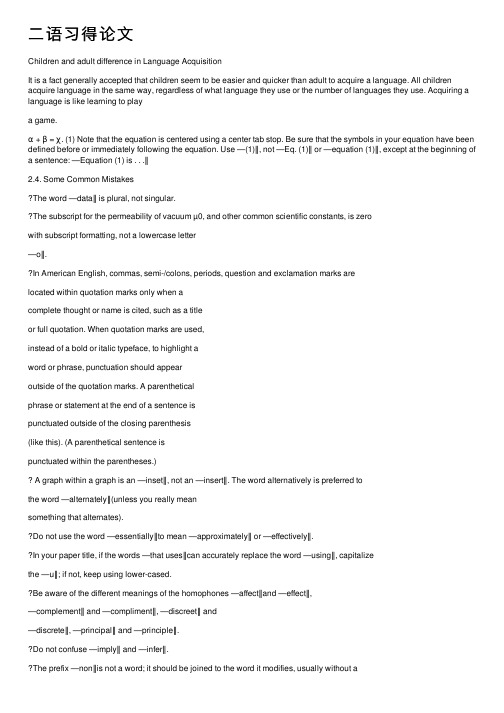
⼆语习得论⽂Children and adult difference in Language AcquisitionIt is a fact generally accepted that children seem to be easier and quicker than adult to acquire a language. All children acquire language in the same way, regardless of what language they use or the number of languages they use. Acquiring a language is like learning to playa game.α + β = χ. (1) Note that the equation is centered using a center tab stop. Be sure that the symbols in your equation have been defined before or immediately following the equation. Use ―(1)‖, not ―Eq. (1)‖ or ―equation (1)‖, except at the beginning ofa sentence: ―Equation (1) is . . .‖2.4. Some Common MistakesThe word ―data‖ is plural, not singular.The subscript for the permeability of vacuum µ0, and other common scientific constants, is zerowith subscript formatting, not a lowercase letter―o‖.In American English, commas, semi-/colons, periods, question and exclamation marks arelocated within quotation marks only when acomplete thought or name is cited, such as a titleor full quotation. When quotation marks are used,instead of a bold or italic typeface, to highlight aword or phrase, punctuation should appearoutside of the quotation marks. A parentheticalphrase or statement at the end of a sentence ispunctuated outside of the closing parenthesis(like this). (A parenthetical sentence ispunctuated within the parentheses.)A graph within a graph is an ―inset‖, not an ―insert‖. The word alternatively is preferred tothe word ―alternately‖(unless you really meansomething that alternates).Do not use the word ―essentially‖to mean ―approximately‖ or ―effectively‖.In your paper title, if the words ―that uses‖can accurately replace the word ―using‖, capitalizethe ―u‖; if not, keep using lower-cased.Be aware of the different meanings of the homophones ―affect‖and ―effect‖,―complement‖ and ―compliment‖, ―discreet‖ and―discrete‖, ―principal‖ and ―principle‖.Do not confuse ―imply‖ and ―infer‖.The prefix ―non‖is not a word; it should be joined to the word it modifies, usually without ahyphen.There is no period after the ―et‖in the Latin abbreviation ―et al.‖.The abbreviation ―i.e.‖means ―that is‖, and the abbreviation ―e.g.‖ means ―for example‖.An excellent style manual for science writers is [7].3. Using the TemplateAfter the text edit has been completed, the paper is ready for the template. Duplicate the template file by using the Save As command, and use the naming convention prescribed by your conference for the name of your paper. In this newly created file, highlight all of the contents and import your prepared text file. You are now ready to style your paper; use the scroll down window on the left of the MS Word Formatting toolbar.3.1 Authors and AffiliationsThe template is designed so that author affiliations are not repeated each time for multiple authors of the same affiliation. Please keep your affiliations as succinct as possible (for example, do not differentiate among departments of the same organization). This template was designed for two affiliations.1)For author/s of only one affiliation (Heading 3): To change the default, adjust the template as follows.a)Selection (Heading 4): Highlight all author and affiliation lines.b)Change number of columns: Select the Columns icon from the MS Word Standard toolbar and then select ―1 Column‖from the selection palette.c)Deletion: Delete the author and affiliation lines for the second affiliation.2)For author/s of more than two affiliations: To change the default, adjust the template as follows.a)Selection: Highlight all author and affiliation lines.b)Change number of columns: Select the ―Columns‖ icon from the MS Word Standard toolbar and then select ―1 Column‖from the selection palette.c)Highlight author and affiliation lines of affiliation 1 and copy this selection.d)Formatting: Insert one hard return immediately after the last character of the last affiliation line. Then paste down the copy of affiliation 1. Repeat as necessary for each additional affiliation.e)Reassign number of columns: Place your cursor to the right of the last character of the last affiliation line of an even numbered affiliation (e.g., if there are five affiliations, place your cursor at end of fourth affiliation). Drag the cursor up to highlight all of the above author and affiliation lines. Go to Column icon and select ―2 Columns‖. If you have an odd number of affiliations, thefinal affiliation will be centered on the page; all previous will be in two columns. 3.2. Identify the HeadingsHeadings, or heads, are organizational devices that guide the reader through your paper. There are two types: component heads and text heads.Component heads identify the different components of your paper and are not topically subordinate to each other. Examples include A CKNOWLEDGMENTS and R EFERENCES and, for these, the correct style to use is ―Heading 5‖. Use ―figure caption ‖ for your Figure captions, and ―table head ‖ for your table title. Run-in heads, such as ―Abstract ‖, will require you to apply a style (in this case, italic) in addition to the style provided by the drop down menu to differentiate the head from the text.Text heads organize the topics on a relational, hierarchical basis. For example, the paper title is the primary text head because all subsequent material relates and elaborates on this one topic. If there are two or more sub-topics, the next level head (uppercase Roman numerals) should be used and, conversely, if there are not at least two sub-topics, then no subheads should be introduced. Styles named ―Heading 1‖, ―Heading 2‖, ―Heading 3‖, and ―Heading 4‖ are prescribed. 3.3. Figures and Tables3) Positioning Figures and Tables: Place figures and tables at the top and bottom of columns. Avoid placing them in the middle of columns. Large figures and tables may span across both columns. Figure captions should be below the figures; table heads should appear above the tables. Insert figures and tables after they are cited in the text. Use the abbreviation―Fig. 1‖, even at the beginning of a sentence.a. Sample of a Table footnote. (Table footnote)Figure 1. Example of a figure caption. (figure caption)Figure Labels: Use 8 point Times New Roman Figure labels. Use words rather than symbols abbreviations when writing Figure axis labels to confusing the reader. As an example, write ―Magnetization ‖, or ―Magnetization, M ‖, not just ―M ‖. If including units in the label, present them within parentheses. Do not label axes only with units. In the example, write―Magnetization (A/m)‖ or ―Magnetization {A[m(1)]}‖, not just ―A/m ‖. Do not label axes with a ratio of quantities and units. For example, write ―Temperature (K)‖, not ―Temperature/K ‖.4. Acknowledgment (Heading 5)The preferred spelling of the word ―acknowledgment ‖ in America is without an ―e ‖ after the ―g ‖. Avoid the stilted expression, ―One of us (R. B. G.) thanks . . .‖ Instead, try ―R. B. G. thanks ‖. Put sponsor acknowledgments in the unnum-bered footnote on the first page.ReferencesThe template will number citations consecutively within brackets [1]. The sentence punctuation follows the bracket [2]. Refer simply to the reference number, as in [3]—do not use ―Ref. [3]‖ or ―reference [3]‖ except at the beginning of a sentence:―Reference [3] was the first . . .‖Number footnotes separately in superscripts. Place the actual footnote at the bottom of the column in which it was cited. Do not put footnotes in the reference list. Use letters for table footnotes.Unless there are six authors or more give all authors' names; do not use ―et al.‖. Papers that have not been published, even if they have been submitted for publication, should be cited as ―unpublished ‖ [4]. Papers that have been accepted for publication should be cited as ―in press ‖ [5]. Capitalize only the first word in a paper title, except for proper nouns and element symbols.For papers published in translation journals, please give the English citation first, followed by the original foreign-language citation [6].[1] G. Eason, B. Noble, and I. N. Sneddon, ―On certain integrals ofLipschitz-Hankel type involving products of Bessel functions,‖ Phil. Trans. Roy. Soc. London, vol. A247, pp. 529–551, April 1955. (references)[2] J. Clerk Maxwell, A Treatise on Electricity and Magnetism, 3rded., vol. 2. Oxford: Clarendon, 1892, pp.68–73.[3] I. S. Jacobs and C. P. Bean, ―Fine particles, thin films and‖ J. Electron plastic 2, pp. [7] M. Young, The Technical Writer's Handbook. Mill Valley, CA:University Science, 1989.。
中学英语论文范文推荐(共2篇)

中学英语论文范文推荐(共2篇)篇一:如何提高中学生英语口语能力英语口语能力一直是中学生学习英语的重要部分,但事实上许多中学生在这方面存在较大的困惑。
有的学生虽然在听、写方面表现得不错,但是一到口语,就显得非常尴尬和紧张。
如何提高中学生的英语口语能力,成为一个需要着重研究、反思和探究的问题。
本文将讨论和提出一些可行的策略和方法。
首先,英语口语训练需要注重语言环境和实际应用。
中学生学习英语时,多数情况下是在课程和书本中接触英语。
因此在课外,重点突出实际语言环境帮助中学生习得口语。
例如听英语电影、电视、新闻等,实践英语口语的语言交流、发音、语调等各个方面。
另外,学生需要在日常生活中从英语入手,例如用英语叙述一些日常事物、环境以及感受,增加实践环节,使学生更好的掌握语感并提高口语流畅度。
其次,与英语语言的学习、习得和实际应用相关的学科也应该加强。
比如,让学生了解和学习一些英语国家的文化、历史,同时加强中英文差异的意识,以及英语语言发展历程等等,让学生更加深入的了解和掌握英语。
这不仅能让学生更好地理解英语语言的背景,同时也可以提高学生的语感,加强口语能力。
最后,多样化的口语学习方式可以给中学生带来新的口语学习体验。
这包括创造小组讨论的环境,与同学结伴互相模仿英语口音的训练,练习英语语音乐器的表达能力,以及课堂上加入一些游戏和小故事等方法。
通过多种学习方式,增强学生的兴趣和动机,让学生在轻松、愉快的氛围中提高口语能力。
总之,提高中学生英语口语能力是一个相对复杂的过程,需要依靠多种不同的方法和策略。
这些方法和策略必须与学生的语言环境相结合,并且需要多样化、灵活,充满趣味性、实践性和田野性,以此来保证学生能够在口语训练中取得最佳的效果。
篇二:为什么中学英语文化教育如此重要中学英语课程旨在使学生掌握英语语言基础知识并在交流中应用它们。
然而,中学英语教育不仅仅是语言教育,还包括文化教育,重要性不言自明。
本文将探讨中学英语文化教育的重要性和理由。
英语学术论文 lecture 2 练习部分答案
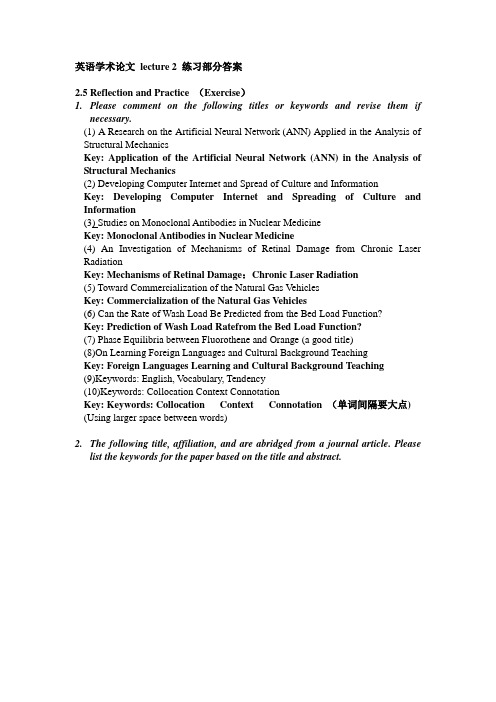
英语学术论文lecture 2 练习部分答案2.5 Reflection and Practice (Exercise)1.Please comment on the following titles or keywords and revise them ifnecessary.(1) A Research on the Artificial Neural Network (ANN) Applied in the Analysis of Structural MechanicsKey: Application of the Artificial Neural Network (ANN) in the Analysis of Structural Mechanics(2) Developing Computer Internet and Spread of Culture and InformationKey: Developing Computer Internet and Spreading of Culture and Information(3) Studies on Monoclonal Antibodies in Nuclear MedicineKey: Monoclonal Antibodies in Nuclear Medicine(4) An Investigation of Mechanisms of Retinal Damage from Chronic Laser RadiationKey: Mechanisms of Retinal Damage:Chronic Laser Radiation(5) Toward Commercialization of the Natural Gas VehiclesKey: Commercialization of the Natural Gas Vehicles(6) Can the Rate of Wash Load Be Predicted from the Bed Load Function?Key: Prediction of Wash Load Ratefrom the Bed Load Function?(7) Phase Equilibria between Fluorothene and Orange (a good title)(8)On Learning Foreign Languages and Cultural Background TeachingKey: Foreign Languages Learning and Cultural Background Teaching(9)Keywords: English, V ocabulary, Tendency(10)Keywords: Collocation Context ConnotationKey: Keywords: Collocation Context Connotation (单词间隔要大点) (Using larger space between words)2.The following title, affiliation, and are abridged from a journal article. Pleaselist the keywords for the paper based on the title and abstract.bine each of the groups of sentences below into a sound sentencecontaining one absolute.(1)Air resistance is neglected.The acceleration of gravity continually increases as the body approaches the earth.(答案:The acceleration of gravity continually increases as the body approaches the earth, air resistance being neglected. )(2)Almost all metals are good conductors.Silver is the best.(答案:Almost all metals are good conductors, silver being the best.)(3)In Group 1, we have hydrogen and the alkali(碱) metals.All of them have low density.(答案:In Group 1, we have hydrogen and the alkali metals,all of low density.)(4)There are many reasons for this.One of the reasons is that simulation allows the assessment of the potentialperformance before a newly designed system is operable.(答案:There are many reasons for this, among them the fact that simulation allows the assessment of the potential performance before a newly designed system is operable.)(5)Laser’s creation is thought to be one of today’s wonders.Laser’s nothing more than a light that differs from ordinary lights.(答案:Laser, its creation being thoug ht to be one of today’s wonders, i s nothing more than a light that differs from ordinary lights.)。
双语精读材料范文
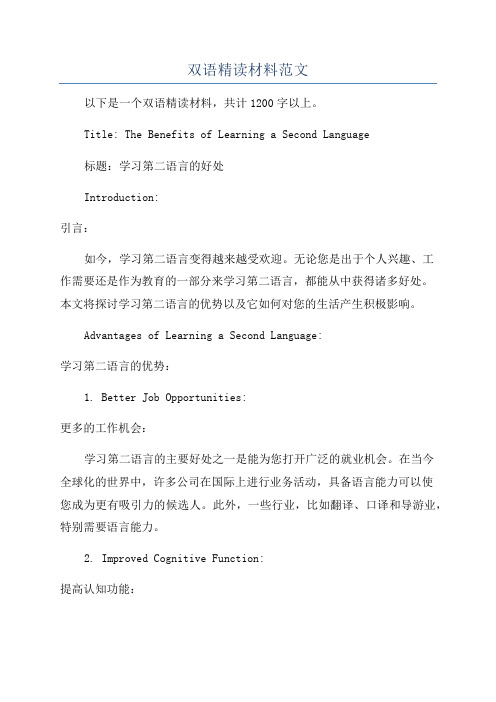
双语精读材料范文以下是一个双语精读材料,共计1200字以上。
Title: The Benefits of Learning a Second Language标题:学习第二语言的好处Introduction:引言:如今,学习第二语言变得越来越受欢迎。
无论您是出于个人兴趣、工作需要还是作为教育的一部分来学习第二语言,都能从中获得诸多好处。
本文将探讨学习第二语言的优势以及它如何对您的生活产生积极影响。
Advantages of Learning a Second Language:学习第二语言的优势:1. Better Job Opportunities:更多的工作机会:学习第二语言的主要好处之一是能为您打开广泛的就业机会。
在当今全球化的世界中,许多公司在国际上进行业务活动,具备语言能力可以使您成为更有吸引力的候选人。
此外,一些行业,比如翻译、口译和导游业,特别需要语言能力。
2. Improved Cognitive Function:提高认知功能:Learning a second language has been found to enhancecognitive function. It improves memory, problem-solvingabilities, and attention span. Bilingual individuals oftenexhibit better multitasking skills and have an increased ability to focus. Learning a second language challenges the brain and keeps it active, which can help delay neurodegenerative diseases such as dementia and Alzheimer's.研究发现,学习第二语言可以增强认知功能。
道林格雷的画像论文Literature Review 2
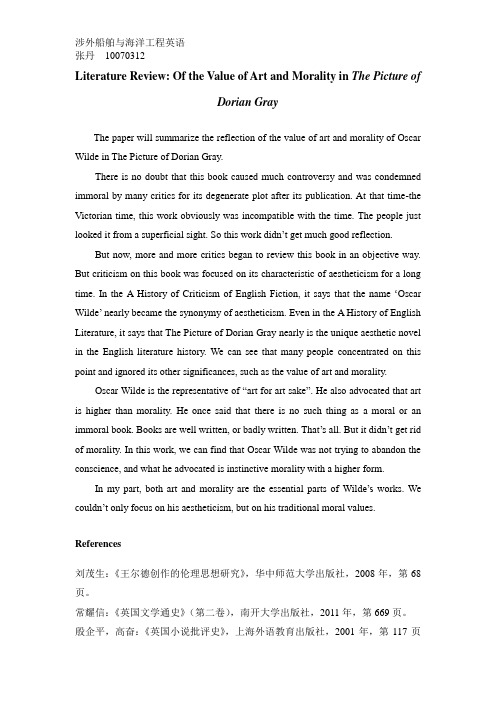
Literature Review: Of the Value of Art and Morality in The Picture ofDorian GrayThe paper will summarize the reflection of the value of art and morality of Oscar Wilde in The Picture of Dorian Gray.There is no doubt that this book caused much controversy and was condemned immoral by many critics for its degenerate plot after its publication. At that time-the Victorian time, this work obviously was incompatible with the time. The people just looked it from a superficial sight. So this work didn‟t get much good reflection.But now, more and more critics began to review this book in an objective way. But criticism on this book was focused on its characteristic of aestheticism for a long time. In the A History of Criticism of English Fiction, it says that the name …Oscar Wilde‟ nearly became the synonymy of aestheticism. Even in the A History of English Literature, it says that The Picture of Dorian Gray nearly is the unique aesthetic novel in the English literature history. We can see that many people concentrated on this point and ignored its other significances, such as the value of art and morality.Oscar Wilde is the representative of “art for art sake”. He also advocated that art is higher than morality. He once said that there is no such thing as a moral or an immoral book. Books are well written, or badly written. That‟s all. But it didn‟t get rid of morality. In this work, we can find that Oscar Wilde was not trying to abandon the conscience, and what he advocated is instinctive morality with a higher form.In my part, both art and morality are the essential parts of Wilde‟s works. We couldn‟t only focus on his aestheticism, but on his traditional moral values.References刘茂生:《王尔德创作的伦理思想研究》,华中师范大学出版社,2008年,第68页。
450字的英语议论文作文
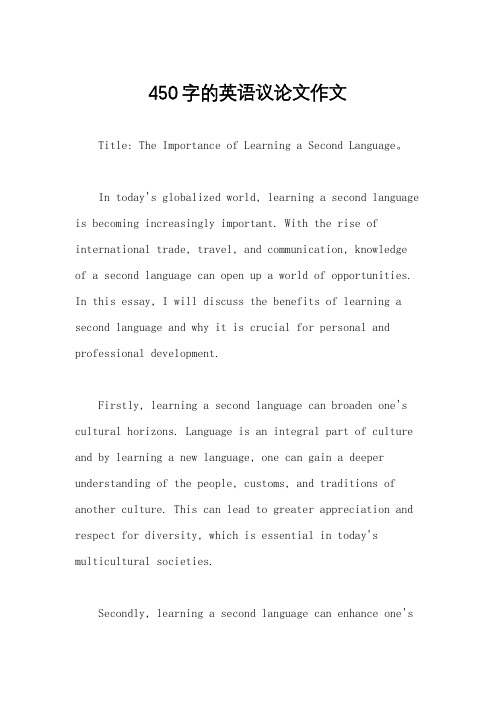
450字的英语议论文作文Title: The Importance of Learning a Second Language。
In today's globalized world, learning a second language is becoming increasingly important. With the rise of international trade, travel, and communication, knowledge of a second language can open up a world of opportunities. In this essay, I will discuss the benefits of learning a second language and why it is crucial for personal and professional development.Firstly, learning a second language can broaden one's cultural horizons. Language is an integral part of culture and by learning a new language, one can gain a deeper understanding of the people, customs, and traditions of another culture. This can lead to greater appreciation and respect for diversity, which is essential in today's multicultural societies.Secondly, learning a second language can enhance one'scognitive abilities. Research has shown that bilingualism improves cognitive functions such as memory, attention, and problem-solving skills. This is because the brain is constantly switching between two languages, which strengthens neural pathways and improves overall cognitive flexibility.Thirdly, learning a second language can improve job prospects. In today's competitive job market, employers are increasingly looking for candidates who can speak more than one language. This is especially true for jobs in international business, tourism, and diplomacy. Knowing a second language can give job seekers a competitive edge and increase their chances of landing their dream job.Lastly, learning a second language can enrich one's personal life. It can open up new opportunities for travel, allowing one to communicate with locals and experience new cultures more deeply. It can also lead to new friendships and connections with people from different backgrounds, which can be incredibly rewarding.In conclusion, learning a second language is essential in today's globalized world. It can broaden cultural horizons, enhance cognitive abilities, improve job prospects, and enrich personal life. As such, it is important for individuals to take advantage of the many resources available to learn a second language and reap the benefits that come with it.。
学前教育双语教育论文(通用6篇)
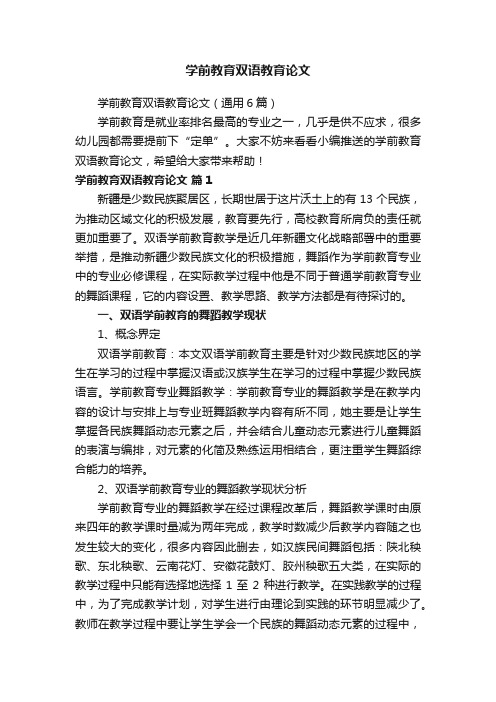
学前教育双语教育论文学前教育双语教育论文(通用6篇)学前教育是就业率排名最高的专业之一,几乎是供不应求,很多幼儿园都需要提前下“定单”。
大家不妨来看看小编推送的学前教育双语教育论文,希望给大家带来帮助!学前教育双语教育论文篇1新疆是少数民族聚居区,长期世居于这片沃土上的有13个民族,为推动区域文化的积极发展,教育要先行,高校教育所肩负的责任就更加重要了。
双语学前教育教学是近几年新疆文化战略部署中的重要举措,是推动新疆少数民族文化的积极措施,舞蹈作为学前教育专业中的专业必修课程,在实际教学过程中他是不同于普通学前教育专业的舞蹈课程,它的内容设置、教学思路、教学方法都是有待探讨的。
一、双语学前教育的舞蹈教学现状1、概念界定双语学前教育:本文双语学前教育主要是针对少数民族地区的学生在学习的过程中掌握汉语或汉族学生在学习的过程中掌握少数民族语言。
学前教育专业舞蹈教学:学前教育专业的舞蹈教学是在教学内容的设计与安排上与专业班舞蹈教学内容有所不同,她主要是让学生掌握各民族舞蹈动态元素之后,并会结合儿童动态元素进行儿童舞蹈的表演与编排,对元素的化简及熟练运用相结合,更注重学生舞蹈综合能力的培养。
2、双语学前教育专业的舞蹈教学现状分析学前教育专业的舞蹈教学在经过课程改革后,舞蹈教学课时由原来四年的教学课时量减为两年完成,教学时数减少后教学内容随之也发生较大的变化,很多内容因此删去,如汉族民间舞蹈包括:陕北秧歌、东北秧歌、云南花灯、安徽花鼓灯、胶州秧歌五大类,在实际的教学过程中只能有选择地选择1至2种进行教学。
在实践教学的过程中,为了完成教学计划,对学生进行由理论到实践的环节明显减少了。
教师在教学过程中要让学生学会一个民族的舞蹈动态元素的过程中,要快速地简单讲解该动态元素的基本特征及该动态元素在学习的过程中应如何更准确的掌握,其重点是在动作的教授过程中,而对该民族的地域、文化、民俗部分的讲解,该环节在教学过程中往往被教师们所忽略。
- 1、下载文档前请自行甄别文档内容的完整性,平台不提供额外的编辑、内容补充、找答案等附加服务。
- 2、"仅部分预览"的文档,不可在线预览部分如存在完整性等问题,可反馈申请退款(可完整预览的文档不适用该条件!)。
- 3、如文档侵犯您的权益,请联系客服反馈,我们会尽快为您处理(人工客服工作时间:9:00-18:30)。
“双语”教学存在的问题与研究改革
我国是一个多种民族语言、多方言的国家,汉语不仅是汉民族共同语,也是国家通用语。
学习汉语,掌握汉语是至关重要的。
所以国家一直很重视双语教学。
随着经济大变革,商品大流通,人员大流动,民族地区越来越多的人意识到:少数民族要走向世界,必先走向全国,而走向全国,必须通过语言关。
新疆是个多民族聚居的地区,维吾尔、哈萨克、蒙古等少数民族都拥有本民族的语言和文字。
所以双语教育更为重要,在精通本民族语言和文字的同时,还要学好国家通用语————汉语。
学习国家通用语有利于增进各民族之间的交流,维护国家的统一,增强中华民族凝聚力。
语言文字是文化的重要载体。
语言文字能力是文化素质的基本因素,学习国家通用语是学校素质教育的重要内容。
为此,国家制定了双语教育计划。
双语教育的根本目的,是依赖于本族语言的天然条件,进一步学好使用第二语言,促进个人以至整个社会的进步与发展。
双语教学是实现沟通的桥梁,学习的目的是为了更好地实现各民族间的交流与互动、沟通与信任,让每个孩子都拥有平等的机会学习和掌握先进文化与科学知识。
所以,双语教育是民族教育的一个重要组成部分,搞好双语教育有利于民族教育的发展。
双语教学是我国整个西部地区教育的重要组成部分。
对我们新疆来讲,它是教育的基础部分。
深入研究双语教育问题有利于促进西部大开发战略的实施,有利于民族教育的发展和教育质量的提高。
双语教师短缺,为了不影响教学工作的正常开展,学校只好安排
汉语水平稍好的教师从事双语教学工作,为此,双语教师水平层次不齐。
这是出现的一大问题,不过国家这几年也在培育着双语人才,我曾就读于新疆教育学院汉语定向班,我就是一名国家培育的双语教师。
在工作岗位上,我深刻的体会到了双语教师的短缺,现有在岗汉语教师不仅数量不足,而且在教学业务水平和汉语言文字能力运用上也在不同程度上存在着达不到基本要求的问题。
汉语教师中100%是少数民族教师,农区汉语交际环境相对较差,不少汉语教师刚从学院毕业时还能说一口流利的汉语,但在回到自己母语环境下从事汉语教学工作中,由于除课堂上极少时间使用汉语外,大部分时间都使用母语交际,汉语水平不仅没有提高,反而不断下降,以致于不能胜任汉语教学工作。
我区少数民族学生是以乡村为单位相对集中聚居。
在少数民族绝对聚居的地区,母语是人们生活、工作和学习的强势语言,汉语几乎起不到主流语言的作用。
由于没有汉语言环境,学生离开教室全用维语,有的教师就是用维语授课,学生听说能力差的重要原因之一就在于此。
在这种条件下,没学汉语的学生难以学好,已经觉得不错的汉语水平也会退化。
不仅学生学不好,教师自身的汉语水平也在不断下降,有的教师是在内地上的大学,汉语很好,回来后几年不用,水平逐渐退化了。
汉语交际环境差,汉语教师汉语整体水平和汉语运用能力不高,学生在学校仅能学到简单的汉语知识,回到家庭生活环境周围也很难有使
用汉语进行交际的机会,因此在汉语学习上困难较大。
四、加强双语教师的汉语能力
推进双语教育、提高教学质量,关键在于培养一支合格的双语教师队伍,为此,学校根据自身实际,制定双语培训方案。
双语教师、数学、综合教师都要参加“双语教学”培训活动,学校根据教师的汉语实
际水平,将教师分为高、低两组,有组织,有计划,分期分批的安排实施培训。
总之,双语教学与研究改革是一项庞大的系统工程,需要更多的双语教师的不懈努力和投入。
我们希望双语教师和教学研究工作者同心协力,立足于自己的教学实践,就我校的双语教学、双语教学法等问题进一步进行深入研究和探讨,尽力推动我校双语教学,使之能上一个新的台阶。
